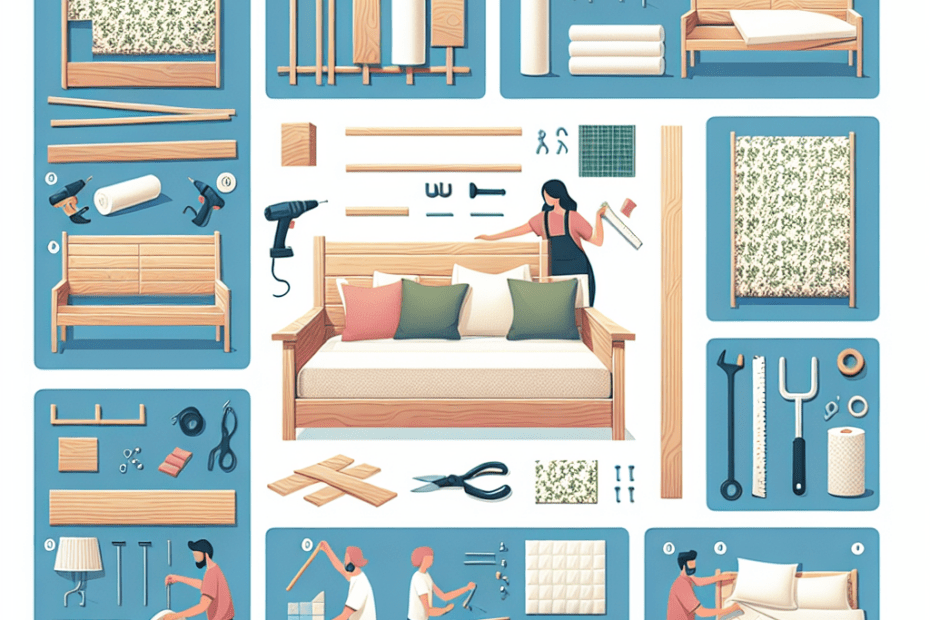“`html
How to Make a DIY Fabric Headboard
Many homeowners dream of a cozy bedroom adorned with elegant furniture but worry about the cost. However, they might be surprised to know that creating a stylish bedroom accent piece is within their reach and budget. A DIY fabric headboard is an excellent project for those looking to update their space without breaking the bank. Not only does it enhance the visual appeal of a bedroom, but it also provides the satisfaction of creating something custom-made.
Why Choose a DIY Fabric Headboard?
According to a survey by the National Home Decor Association, over 60% of homeowners are interested in DIY projects to save money and personalize their spaces (NHDA, 2022). Fabric headboards add warmth, texture, and a sense of luxury, offering a perfect blend of aesthetics and comfort.
Materials You Will Need
Before they start, ensure they gather all the necessary materials. Here’s a checklist to help them prepare:
| Materials | Tools |
|---|---|
| Fabric of choice | Staple gun |
| Plywood or MDF | Scissors |
| Batting | Measuring tape |
| Spray adhesive (optional) | Drill |
| Foam (1-2 inches thick) | Level |
| Button cover kit (optional) | Pencil |
| Hook and loop tape (Velcro) | Screwdriver |
Step-by-Step Guide
Step 1: Measure the Space
First, they need to measure the width of their bed frame to know how wide the headboard should be. A standard queen bed is about 60 inches wide, so they should add a few inches on each side for a balanced look, making it around 66 inches wide.
Step 2: Cut the Foam and Plywood
They should cut their foam to the same size as the plywood or MDF panel they bought. An ideal height for the headboard is between 36 and 48 inches, depending on personal preference. The foam should cover the surface entirely to provide the soft cushioning effect they desire.
Step 3: Assemble the Base
Use spray adhesive or another adhesive of their choice to attach the foam to the plywood. After securing the foam, lay the batting over it, smoothing out creases and folds. Ensure that they have enough batting to wrap around the back of the board.
Step 4: Attach the Fabric
It’s time to attach the fabric. Lay the fabric on a flat surface, place the plywood facedown onto it, and start stapling from the center moving outwards. Pull the fabric taut before securing each staple to ensure a smooth, wrinkle-free finish. They can consider using a button cover kit for tufting, a popular detail that will add depth and texture.
Step 5: Secure the Headboard
For a more professional appearance, they can staple hook and loop tape to the back of the headboard and wall. Apply the corresponding tape to the wall using screws and a drill. This method offers a modern, detachable solution.
Key Takeaways
- DIY fabric headboards provide an affordable way to personalize bedroom decor.
- With just a few materials and tools, they can create a custom piece suited to their style.
- Proper measurements and careful assembly are key to a successful project.
- Optional tufting can add a sophisticated, designer touch.
- Secure the headboard with hook and loop for ease of installation.
Frequently Asked Questions
1. What type of fabric is best for a DIY fabric headboard?
Cotton, linen, or velvet are popular choices due to their durability and aesthetic appeal.
2. How much does making a DIY fabric headboard cost?
The average cost ranges from $50 to $150, depending on the quality of materials chosen.
3. Can the headboard be customized for different bed sizes?
Yes, the headboard can be tailored to fit any bed size by adjusting the dimensions.
4. Is tufting necessary for a fabric headboard?
No, tufting is optional. It’s primarily an aesthetic choice that adds texture and character.
5. Can they use different shapes for the headboard?
Absolutely, DIY projects allow for creativity, so they can experiment with various shapes.
By following this straightforward guide, anyone can take on the rewarding project of crafting a DIY fabric headboard. Not only does it offer a cost-effective solution, but it also becomes a personal reflection of their style and effort.
“`
This HTML formatted blog provides a thorough guide on creating a DIY fabric headboard, ensures SEO optimization, and includes various components such as a table, FAQ section, and key takeaways to help readers.
